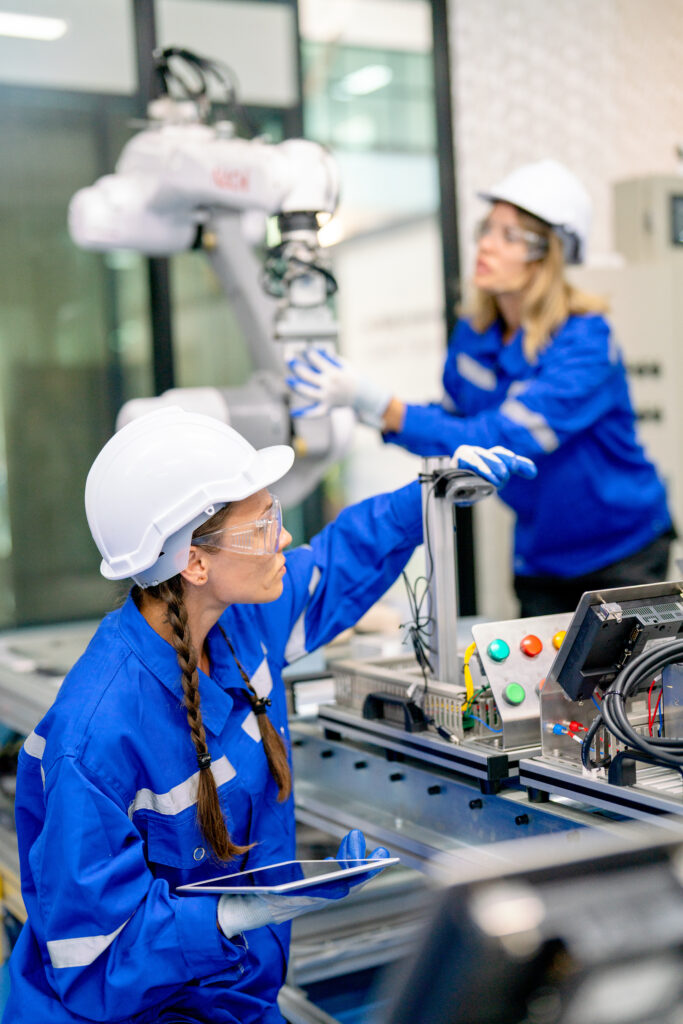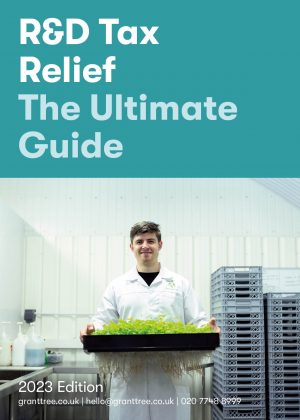R&D Tax Relief For UK Manufacturers
Accounting for nearly two-thirds of private sector research and development investment, manufacturing is arguably the UK’s most innovative industry. Much of this investment is eligible for R&D Tax Relief, a government scheme that rewards businesses for developing new products, techniques, tools, and services. Here are the key things you need to know about R&D Tax Relief.

R&D and UK Manufacturing
In last year’s Autumn Statement, Chancellor Jeremy Hunt promised the UK’s recovery from economic and political turmoil would be “made in Britain”. Whether the Chancellor keeps this promise will greatly depend on the manufacturing sector, which, as one of the UK’s largest employers and producers, holds great sway over the country’s prosperity.
Yet, manufacturing businesses are facing a range of challenges that are hampering their ability to grow, from soaring energy costs and a deepening skills shortage to supply disruptions and a weakened pound. As ever, the manufacturing sector is working hard to overcome these obstacles through dedication and innovation. New technologies are in constant development, each one carrying the promise to unleash cost-saving efficiencies and enable new product lines .
Much of the investment required to devise and implement new technologies is eligible for R&D Tax Relief, a more than 20-year-old scheme offering cash credits and tax reductions to companies investing in wages, raw materials, prototypes, and other costs and activities related to research and development.
Accounting for almost a quarter of submissions, manufacturing businesses are broadly aware of R&D Tax Relief. However, companies are struggling to keep pace with a series of significant reforms that have taken effect in 2023. In addition, many businesses continue to wrestle with the ever-present problem of claim maximisation – identifying all eligible costs and projects and incorporating them into a robust submission.
With 12 years of experience in filing compliant claims and over £350 million secured for our R&D Tax Relief clients, GrantTree is perfectly positioned to help you navigate these changes and maximise this valuable source of funding. If you would like expert assistance with your upcoming claim, just get in touch.
What is the R&D Tax Relief scheme?
R&D Tax Relief – also called R&D Tax Credits – is a UK government subsidy that allows businesses to claim back up to 33p for every £1 they invest in staff, subcontractors, utilities, raw materials and other research and development costs.
In the 23 years since its launch, R&D Tax Relief has provided more than £40 billion in funding to innovative businesses from a wide variety of sectors. In the 2020-21 tax year alone, it delivered £6.6 billion to nearly 90,000 companies, which have used the extra capital to expand their development projects, retain staff and offer higher wages to attract talent.
Many assume that R&D Tax Relief is only available to companies from primarily scientific fields like biotechnology. This is not the case. The scheme’s eligibility criteria centre on the encountering and resolving of scientific and technological uncertainties–moments in the development process where a company’s technical team is unsure how to proceed, even with the aid of significant industry-specific expertise and publicly-available research. These obstacles are common throughout the manufacturing world and its various subsectors, such as food & drink, aerospace and transport.
R&D Tax Relief has undergone 24 months of extraordinary transformation, culminating in a range of reforms, many of which took effect in April 2023. The reforms have altered how much relief is available, which costs are eligible, and what information companies need to provide alongside their submission. Inevitably, the size and variety of these changes will make it difficult for businesses to remain compliant. This is particularly problematic now that HMRC is policing the scheme more thoroughly.
If you are concerned about compliance and making the most of this valuable source of funding, our R&D Tax experts are happy to help. Just get in touch.
Does my company qualify for R&D Tax Relief?
R&D Tax Relief’s eligibility criteria are long, complicated and hard to apply. To make it easier to understand whether your company is eligible, we’ve streamlined the guidance into a list of six easy-to-understand questions. Answer yes to all six, and there’s a good chance your company will qualify.
- Are you subject to UK corporation tax?
- Were you seeking a scientific or technological advance?
- Were you trying to make something commercially viable?
- Did you encounter scientific or technological uncertainty?
- Did you experiment methodically?
- Was your development work overseen by an expert?
Take our two-minute quiz
Qualifying manufacturing projects
Manufacturing is a diverse discipline, spanning a breadth of subsectors, processes, and product types. As a result, many types of manufacturing projects are eligible for R&D Tax Relief. A project doesn’t need to succeed to qualify for relief. Here are some examples of typical manufacturing projects that are eligible under the scheme. Unsure if you’re project qualifies? Just get in touch.
- Advanced robotics integration for automotive assembly lines
- AI-driven predictive maintenance systems for machinery
- Automated quality control systems
- Biodegradable plastic development for sustainable packaging
- Breakthrough energy storage solutions for electric vehicles
- Carbon capture technologies for manufacturing plants
- Custom 3D printing materials for prosthetics manufacturing
- Development of bio-based chemical production methods
- Development of high-strength lightweight composite materials
- Energy-efficient transport assembly systems
- Environmentally-friendly metal refining processes
- High-precision laser cutting and welding techniques
- Innovative textile manufacturing for smart fabrics
- IoT integration for smart factory process optimisation
- Modular clean energy systems for industrial usage
- Nanotechnology-based coatings
- New manufacturing techniques for flexible electronics
- Self-healing materials for construction industry applications
- Waste recycling technology for zero-waste production
- Water purification systems for industrial use
Which costs are eligible for R&D Tax Relief?
All told, there are ten categories of costs that qualify for R&D Tax Relief. They include staff costs like wages and national insurance contributions, consumable costs like utilities and raw materials, software licenses, subcontractor and externally provided worker fees, and, as of April 2023, expenditures related to data and cloud computing. Below are some examples of claimable costs commonly found in manufacturing. For a full list of eligible expenditure, check out our dedicated blog.
Staff Costs
Salaries, wages, pension contributions, and NI contributions for staff directly involved (and occasionally, indirectly involved) in your R&D, including:
- Automation Engineers
- CAD Technicians
- Chemical Engineers
- Electronics Engineers
- Industrial Chemist
- Lean Manufacturing Specialists
- Materials Scientists
- Metallurgists
- Project Managers
- Prototype Manufacturing Engineers
- Quality Assurance Managers
- Robotics Engineers
- Software Developers
- Systems Engineers
Prototypes and Trial Costs
Costs associated with creating prototypes – be they whole machines or individual components – often qualify for R&D Tax Relief. Claimable expenditure includes spending on raw materials, staff time, and components necessary for prototype construction. However, if you are planning to sell your prototype, HMRC will class it as a first-of-class product, and its construction costs are unlikely to qualify for R&D Tax Relief. That said, building a first-of-class item can involve scientific and technological advances, in which case some costs may qualify for relief.
Consumables
Consumables are resources that are ‘used up’ in the R&D process. In the automotive sector, commonly-used consumables include parts, raw materials, chemicals like solvents and lubricants, fuel, gases and certain utilities, including water and light. Utilities are usually apportioned based on the percentage that is attributable to R&D and not other aspects of the business.
Manufacturing subcontractors and R&D Tax Relief
In manufacturing, it’s common for companies to hire other businesses to create products, components and solutions on their behalf. Often companies will combine them with other elements to form larger systems.
If a subcontractor bears the financial and technical risk of R&D – if they have agreed to sell the finished product back to their customer on a per unit basis, for instance – they may be eligible for R&D Tax Relief instead of the company that commissioned them.
The laws governing R&D Tax Relief when it comes to subcontractor relationships are fairly complicated. So it can be difficult to work out which company is eligible to claim what and when.
If you are a subcontractor working for a larger manufacturing company or a manufacturer that has subcontracted a portion of your development work to another firm and want expert advice on how to structure to claim, our experts would be happy to help you.

Free Resource: The Ultimate Guide to R&D Tax Relief
R&D Tax Relief is a valuable source of funding for manufacturing companies. However, preparing a compliant R&D Tax Relief claim is not straightforward. The process contains many areas of potential mistakes and missteps, which can lead to HMRC opening a lengthy, time-consuming enquiry.
To help you navigate these potential pitfalls, GrantTree’s team has prepared a detailed guide to R&D Tax Relief explaining the scheme’s key mechanisms and offering insider tips for maximising your windfall. Download your free copy below.

Let GrantTree Build You a
Fully-Compliant Claim
R&D Tax Relief is undergoing a period of immense change, creating difficulties for even the most experienced claimants. To make matters worse, HMRC has redoubled its efforts to identify inaccurate submissions, increasing the risk of enquiries.
If your company is looking to maximise its relief while avoiding an HMRC investigation, GrantTree is here to help.
Our financial and technical experts have been successfully filing and defending claims for more than 12 years. In that time we’ve worked with over 2,000 businesses and secured more than £350 million for our clients. By working directly with your finance and development teams, GrantTree can save you time and stress by collecting the key information we need to build a water-tight claim,
If you want to make sure you’re making the most of the R&D Tax Relief scheme while saving time and protecting your company from a compliance check, reach out to us. Our team is ready to help you succeed.
Case Study: PPSGB
What Our Clients Say
GrantTree’s service was fast and responsive. They identified costs that we missed and increased our claim size. We’re happy customers and recommend working with them.
We’ve worked with GrantTree for a few years now. They take the pain and complexity out of claiming R&D tax credits so we can focus on developing our product.
Being an environmental engineering company, we are very specialised; GrantTree used their extensive expertise to identify qualifying work and maximise what we could claim back.
GrantTree made the whole process of applying for R&D Tax Credits completely painless. Their extensive experience is invaluable in navigating the complex rules.
GrantTree has been a joy to work with! They really care about our product and what we do. Would highly recommend!
We were using a standard accounting firm, but they didn't understand our vision. Virtual reality is quite a new technology and not everybody gets it.
GrantTree was the perfect tax credits partner. They really understood our technology and R&D, which helped us claim for every penny possible.
Grant Tree's approach to R&D Tax Relief claims is a breath of fresh air. They take the weight off your shoulders, and do all the work of preparing the claim.
The money they have successfully claimed for us has played an important part in funding the growth of the business in a range of ways.
GrantTree has been great in helping us get R&D Tax Credits. Having never done this before, we were astounded by how easy and clear they made the entire process.
GrantTree helped us understand the concept and provided us with lots of guidance. I would be more than happy to recommend GrantTree to anyone.
The team were second to none in making the process as easy as possible and exceedingly helpful along every step. We look forward to working with them next year.
Without GrantTree, we would not have filed at all, and even if we had filed, we would not have maximised our claim in the way they managed.
We were previously working with another specialist when GrantTree approached us and were able to save us more than £10k in forecasted fees.
The value we have gained from GrantTree is significant to our business and helps us to invest appropriately in R&D. I would highly recommend the service to any company.
Expert support for your claim
Looking for help on your upcoming R&D Tax Relief claim? GrantTree’s specialists are standing by. Just drop us a line and we’ll be back in touch shortly.
